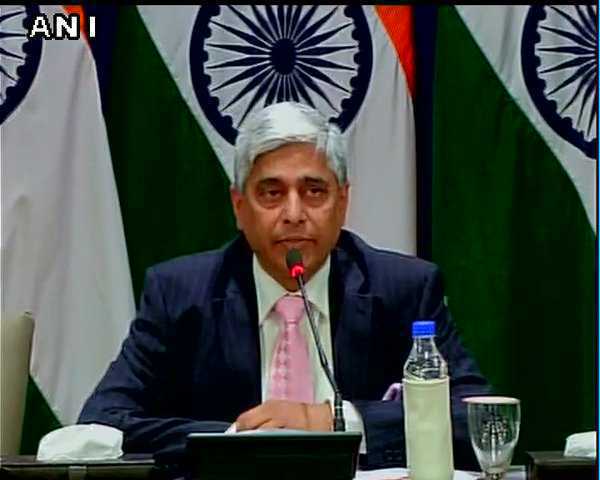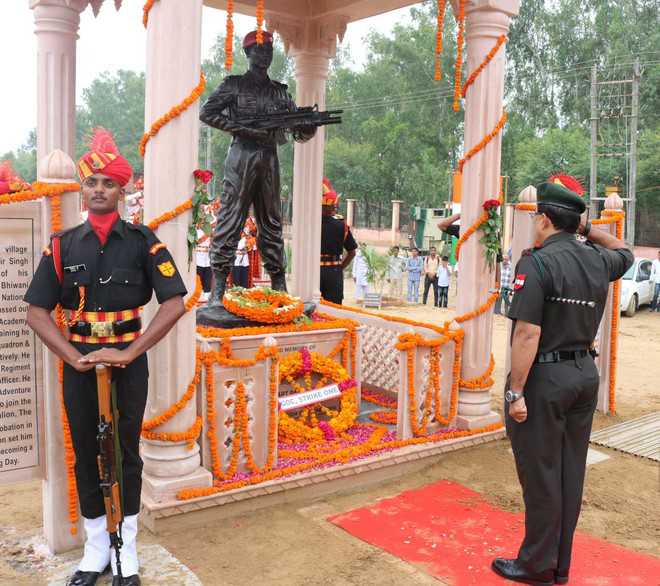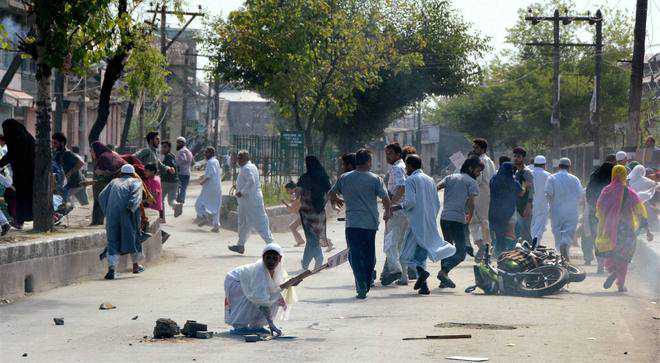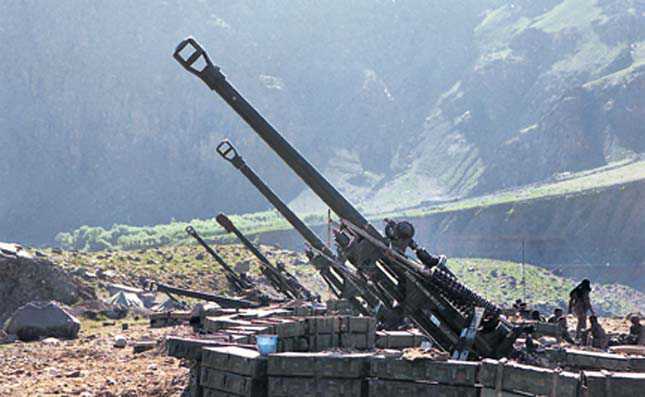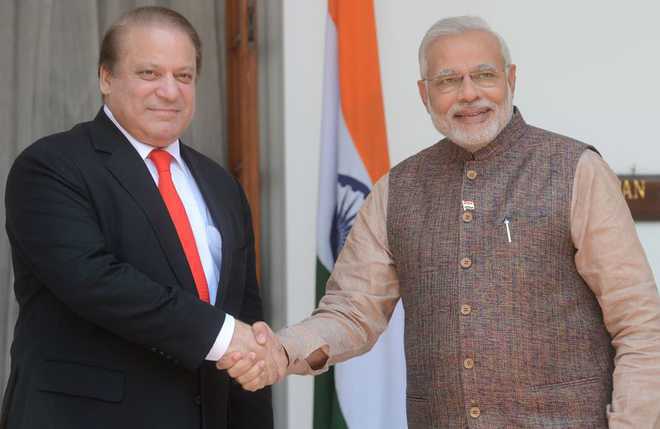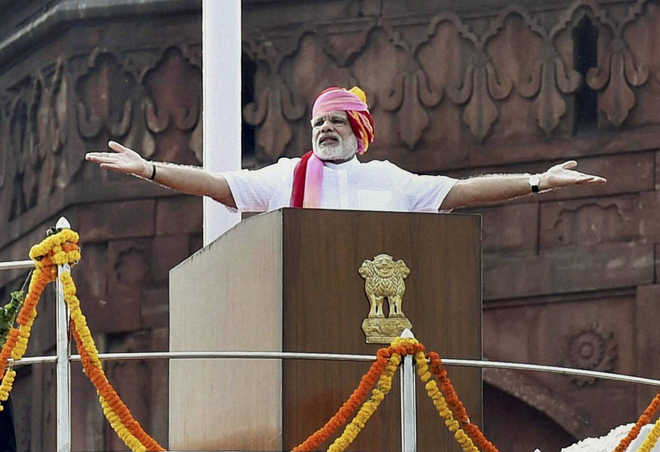By :: Raj Chengappa
Offensive defence. The phrase is an oxymoron that originates from the adage, “the best defence is a good offence”. The principle behind it is to be proactive rather than passive when attacked, thereby regaining the strategic advantage and cramping an opponent’s ability to launch a counter-offensive. Chinese military strategist Sun Tzu was a key advocate of this idea, as was Italian philosopher and diplomat Niccolo Machiavelli. George Washington had employed it to good effect more than 200 years ago when he fought America’s War of Independence. Mao Zedong, too, was a firm believer of the tactic while leading the 1949 Chinese Revolution.
Now, Prime Minister Narendra Modi joins the long list of leaders who have sought to employ this curiously phrased approach to their advantage. In his Independence Day address this year, Modi stunned the Pakistani ruling establishment, which had launched a major international offensive against India following the recent turmoil in Kashmir, by signalling his willingness to take the battle deep into its territory.
From the ramparts of the Red Fort, Modi stated: “Today, I want to greet and express my thanks to some people. In the last few days, the people of Balochistan, Gilgit-Baltistan, Pakistan-occupied Kashmir have thanked me, have expressed gratitude, and expressed good wishes for me. The people who are living far away, whom I have never seen, never met-such people have expressed appreciation for the Prime Minister of India, for 125 crore countrymen. This is an honour for our countrymen.”
MODI’S BOLD GAMBIT ::
Modi’s mention of Pakistan-occupied Kashmir (PoK) was par for the course, as India always regarded reclaiming Gilgit-Baltistan as the “unfinished business of Partition”. But making common cause with the people of the troubled Balochistan province of Pakistan infuriated Islamabad and startled capitals across the world. The ostensible reason was the alleged human rights violations by the Pakistan Army against the protesters who were demanding azadi. But it was viewed as more than just a tit-for-tat response to Pakistan’s charges of ‘brutality’ by the Indian security forces in the Kashmir Valley. Modi was clearly warning Pakistan that India was changing the rules of engagement from its current posture of conciliation to an offensive defence. India was now willing to get tough-and rough, if needed. The implication was that India had decided to make it a costly proposition for Pakistan to back terror groups and strikes.
By upping the ante, the Indian prime minister had slapped the Pakistan Army, particularly its chief Raheel Sharif, with a direct challenge. The army had thwarted any effort by Prime Minister Nawaz Sharif to improve relations with India and is suspected to have engineered the attack on the Pathankot air base this January. India was indicating that it was willing to stir the pot in territories far removed from the Line of Control (LoC). In doing so, Modi was making an audacious gambit fraught with risks.
There were questions raised about whether this was more of a tactical manoeuvre by India to deflect world attention from the ongoing turmoil in Kashmir. Also, whether Modi had thought through taking on Pakistan and China simultaneously, as the move also challenged Beijing’s vital interests in Balochistan. It raised several other concerns: How can India seek world action against Pakistan’s continuing perfidy if it is also seen to be backing separatists? Would India cede the moral high ground in its war against terror if it got involved in Balochistan? Also, if Pakistan raised the stakes and carried out a series of attacks on Indian territory, was India prepared to retaliate strongly and even risk a nuclear war?
THE YO-YO EFFECT ::
From bonhomie to badmouthing, Modi has seen it all in a short span of two years while trying to build relations with India’s hostile neighbour. Opposition parties have charged Modi with following a “yo-yo policy” with Pakistan that is largely knee-jerk, lacks cohesion and has no long-term strategy. Modi backers quote Churchill’s dictum that “consistency is the virtue of only donkeys”. A senior official points out, “You cannot be brain-dead to what the other guy is doing. If the situation is rapidly changing in Pakistan, how can your policy not change? Should we be consistent if Pakistan is inconsistent?”
To his credit, Modi was quick off the blocks with his “neighbourhood first” policy by inviting Nawaz Sharif along with other South Asian leaders for his swearing-in ceremony in May 2014. But the mood changed when foreign secretary-level talks were called off, with India accusing Pakistan of crossing the red line by playing the Hurriyat card. Then, a meeting between Modi and Sharif at Ufa in Russia in July 2015 produced a ray of hope before ending in a fiasco, with talks between the two national security advisors being called off over whether Sartaj Aziz could meet the Hurriyat leaders or not when he came to Delhi. India was clear there would be no third party in the negotiations with Pakistan and would call off talks if Islamabad disrespected it.
Relations were repaired when Modi met Sharif at the sidelines of the Climate Change Summit in Paris in November 2015. Within weeks, there was a breakthrough with Union minister for external affairs Sushma Swaraj announcing in Islamabad, along with her Pakistani counterpart Sartaj Aziz, that the two countries had agreed to restart what they called a Comprehensive Bilateral Dialogue. The word ‘bilateral’ was inserted on the insistence of India to ensure that the Hurriyat would not be involved in the negotiations. The announcement signalled the resumption of formal talks seven years after these were called off, following the Mumbai attack. In a grand gesture, Modi made an impromptu stopover at Lahore on Christmas to greet Sharif on his birthday. Everyone was all smiles, till the Pathankot attack happened a week later.
The attack on the Pathankot air base by heavily armed groups resulted in the death of eight Indians, including seven security personnel, apart from four attackers. For once, Pakistan didn’t deny that the attackers were operating from its soil and pointed to the Jaish-e-Mohammed (JeM) as being responsible. Sharif even had an FIR registered in Gujranwala, based on documents given by India. Then, in April 2016, India agreed to allow a Joint Investigative Team from Pakistan to visit Pathankot to collect evidence for the case-another first.
However, Pakistan inexplicably cooled off when India insisted that, as reciprocity demanded, its investigation agency team go to Gujranwala to cross-examine those arrested. Pakistan High Commissioner Abdul Basit blamed India for embarrassing Sharif by leaking out unsubstantiated findings from the JIT’s visit, breaking the understanding that secrecy would be maintained. He also claimed there was no agreement on reciprocity. India’s deduction was that a serious battle for power between the two Sharifs had broken out and changed the ground dynamics for better relations. The assessment would prove accurate.
SHARIF VS SHARIF ::
In late April, the Panama Papers, containing 11 million documents held by a Panama-based law firm, were leaked. They exposed links between many political leaders and businessmen around the world and revealed the details of offshore companies and accounts. For Nawaz Sharif, this was bad news. The documents showed three of his children owned offshore companies that were not shown in his family’s wealth statement. On the defensive, Sharif rejected the charges and said he would institute an inquiry under a retired judge, but that suggestion was nixed by the Opposition. Army Chief Raheel Sharif chose the occasion to state that terrorism could not be checked unless the “menace of corruption” was not curbed.
Raheel Sharif had grown in popularity after he successfully launched full-fledged army operations, called Zarb-e-Azb, to wipe out Taliban groups inimical to Pakistan in its North Waziristan and Swat regions. He was also credited with cleansing Sindh of terrorists and restoring law and order in strife-torn Karachi. Raheel is to retire this November, and there has been much speculation in the past few months over whether the Nawaz Sharif government will be forced to give him an extension. The power tussle between the two has impacted Pakistan’s relations with India, with the army chief disapproving of Nawaz Sharif’s ‘softness’ towards Modi. This tension began to manifest itself almost immediately on the LoC, with the Indian Army reporting that infiltration attempts went up and money flowed from across the border to militant groups.
Meanwhile, China began to increase its efforts to build the $46 billion China Pakistan Economic Corridor (CPEC), which it had announced the previous year. Described as a “game-changer”, China proposes to build a highway which runs from Kashgar in China, through PoK, including Gilgit-Baltistan, right up to Gwadar in Balochistan, on the edge of the Persian Gulf. The plan also includes building power projects that will add 10,400 MW to the grid and ease Pakistan’s power shortage. India vociferously protested to China, saying they were building the highway through the disputed territory of PoK. Raheel flew to China to seal a deal that would give army protection to the whole project (see accompanying report).
Under its all-powerful president Xi Jinping, China also began to assert itself aggressively on international issues. India felt the heat when it openly backed Pakistan and vetoed India’s membership for the Nuclear Suppliers Group (NSG). China also blocked a move at the UN Security Council to bring sanctions against JeM chief Masood Azhar despite India’s protests. Emboldened by China’s support, Pakistan began meddling in Kashmir again with renewed vigour. Then, much to Pakistan’s glee, Kashmir began to spin out of control because of internal dissensions in India.
THE KASHMIR TRIGGER ::
When the People’s Democratic Party (PDP) and the BJP formed the historic coalition government, with Mufti Mohammed Sayeed as the chief minister of Jammu & Kashmir, in January 2015, Pakistan was dismayed. It had hoped to prey on the fractured mandate in the assembly elections, but the coming together of the Hindu right-wing BJP with the Muslim soft-separatist PDP put paid to its plans. Sayeed had hoped to be the bridge between his state and India and between India and Pakistan, but that was not to be. His untimely death in January 2016 propelled his reluctant daughter, Mehbooba Mufti, to power.
Mehbooba’s supporters in Kashmir were uncomfortable with the alliance with the BJP, and she refused to assume charge till Modi put in a set of confidence-building measures in place. Barely three months after she took over as the state’s first woman chief minister, security forces killed Burhan Muzaffar Wani in an encounter in Kokernag on July 8. Though he was proclaimed as the poster-boy of the new militancy sweeping the Valley, security and police forces regarded him largely as a ‘virtual tiger’ because of his extensive use of social media.
Both the state and central government underestimated the backlash that would follow, and did not take adequate security measures for his funeral, for which there was a massive turnout, followed by a wave of protests. Wani’s death proved to be the trigger for simmering discontent that had spread in the Valley, especially among the youth. The resultant confrontation with security forces has led to more than 68 deaths, and parts of the Valley have been under curfew for over a month-and-a-half.
Though much of the initial uprising was spontaneous, Pakistan seized the opportunity and reportedly activated its dormant cells in the Valley to add fuel to the flames. It simultaneously launched an international propaganda campaign on Kashmir. Under pressure, Nawaz Sharif, who had so far maintained a restraint in his statements against India, stepped up the rhetoric, saying that it was ‘obligatory’ of him to become the “voice of Kashmir”. He shot off letters to the UN Secretary General and the UN High Commissioner for Human Rights, urging them to intervene to end the “persistent and egregious violation of basic human rights”. Part of the noise was for electoral politics in PoK, with the so-called Azad Jammu & Kashmir (AJK) elections being held last month, and Sharif’s party, the PML (N), winning a majority.
Meanwhile, Modi moved swiftly to bring the situation under control. Union home minister Rajnath Singh was sent to the state to provide whatever assistance was required. The prime minister then held an all-party meeting to discuss the best course of action and bring a unity of purpose. Modi and his team were angered by Pakistan’s demand for a foreign secretaries’ meeting to discuss Kashmir’s internal situation. Rajnath too was shown discourtesy when he went to Islamabad for the SAARC summit, where Pakistan interior minister Chaudhry Nisar Ali Khan didn’t attend the lunch he had hosted. There was also the much tom-tommed arrest in Balochistan of Kulbhushan Jadhav, who was charged with being an Indian spy (South Block called it ‘absurd’), and was refused consular access by Pakistan. It was then that Modi, ever willing to take risks, went on the offensive and played the Balochistan card.
WHY THE ‘B’ WORD ::
Why Balochistan? Simply because, apart from being Pakistan’s largest and most backward province, it provides a strategic passage to West Asia and Central Asia. The province harbours the Gwadar port, whose modernisation China has invested in heavily, along with leasing mines to tap its abundant gold and copper deposits. Much of the ambitious CPEC project cuts through Balochistan, making it of crucial importance.
Balochistan is also Pakistan’s Achilles’ heel. It has a 2,500-km border with Afghanistan and Iran that has been the hotbed of cross-border militancy and strife. Since the merger with Pakistan in 1948, the Balochis have waged periodic battles for both autonomy and azadi that have often been brutally crushed by the Pakistan security forces. India’s external intelligence agency, the Research & Analysis Wing (RAW), has been regularly accused by Islamabad of fomenting insurgency, though it has never come up with convincing proof.
In 2009, when Manmohan Singh, as prime minister, permitted the mention of Balochistan in a joint statement with his Pakistan counterpart Yousaf Raza Gilani at Sharm el-Sheikh, he was castigated for his ‘blunder’ by BJP leaders, who said “the waters of the seven seas won’t be able to wash the shame”. It was seen as conceding that India was meddling in Pakistan’s affairs and Manmohan was forced to backtrack. It must be galling to the former prime minister that while he was accused of being timid for putting Balochistan on the table, Modi’s statements are being hailed as bold and brave by experts.
Modi’s backers dismiss criticism about having double standards on Balochistan. A senior official pointed out that when Manmohan mentioned the B-word, it was a defensive reaction to accusations made by Pakistan that India was stirring trouble in Balochistan, and he had agreed to discuss their concerns. In Modi’s case, he argues, India is on the offensive by charging Pakistan with human rights violations in Balochistan. Using a cricketing analogy, he says, “If you pick up a bat and get bowled, it’s not the same thing as me hitting it for a six.”
To criticism from Pakistan that India had crossed the ‘red line’ while invoking Balochistan, India’s foreign affairs spokesperson Vikas Swarup retorted, “Pakistan recognises no red lines in its own diplomacy. Its record of cross-border terrorism and infiltration is at the heart of the problem of the region today.” He also pointed out that India had raised concerns about human rights violations in Balochistan several times in the past. Another official asked whether there is an ‘unwritten rule’ that India and Pakistan keep their conversations to disagreements and violent activities in Kashmir. Pakistan is known to have gone beyond Kashmir in the past, extending support to the Khalistan movement and facilitating terror strikes in Mumbai and Pathankot. As the official puts it, “If they are not playing by the Queensberry rules, should we be doing it?” Pakistan’s worry is that National Security Advisor A.K. Doval is an offensive defence expert and months before he took charge, he warned Pakistan: “If you do another Mumbai, you will lose Balochistan.”
THE CHALLENGES AHEAD ::
The space for reconciliation between the two countries is narrowing rapidly. Pakistan has instigated activists all over the country to demonise Modi and burn his effigies to whip up nationalistic support on Balochistan. Pakistan officials charge Modi and the RSS of creating a divide with the ulterior motive of winning the forthcoming elections in Uttar Pradesh and Punjab. A Pakistan official said that India is mistaken if it thinks it can destabilise either Balochistan or Gilgit-Baltistan.
Modi and his team’s calculus is that the world is not going to poke its nose into Kashmir. After the Nice, Brussels and Paris attacks, the world has no sympathy for terrorists posing as freedom-fighters. As an official put it, “If Burhan Wani was in their country, would he have been tolerated? Also, Kashmir is like a Ranji match between India and Pakistan, not the Ashes-so Pakistan won’t gain any traction.” The prime minister has wisely engaged the entire political spectrum on what to do next in Kashmir. He has heeded former J&K chief minister Omar Abdullah’s request to “find a more permanent solution” by engaging all political forces.
By raising Balochistan, Modi has succeeded in blunting Pakistan’s offensive on Kashmir and also addressed the public demand for a strong answer. But it has limited tactical utility. While Iran and Afghanistan may be happy that India is taking on Pakistan on Balochistan, they would be wary as they have sizeable populations of Balochis in their respective countries.
China, too, may begin to flex its muscle, and India would find it difficult to combat two foes on its borders. So Modi needs to follow intent with action. He needs to have an organised game plan to follow through in a carefully calibrated manner. Modi has shown that he is capable of thinking out of the box. But he has to be careful not to be boxed in by his actions.
– – – – – – – – – – – – – – –
Follow the writer on Twitter @rajchengappa













